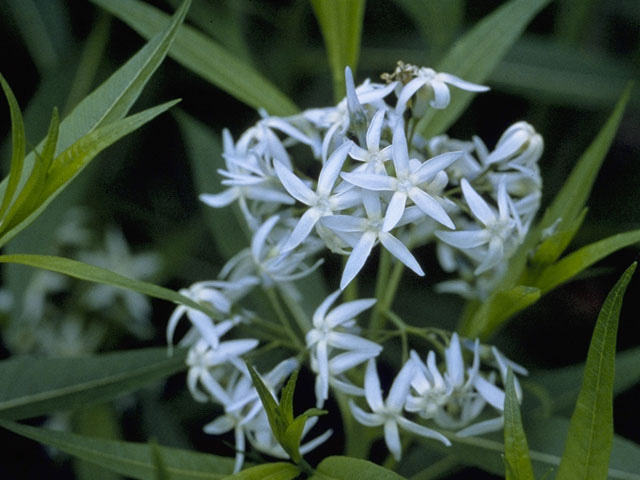Amsonia tabernaemontana: Eastern Blue Star

Latin name: Amsonia tabernaemontana
Common name: Eastern Bluestar, Blue Dogbane
Flowers: ¾”, delicate blue star-like flowers12 in March, April, and May10
Fruit: Tan, slender follicles containing corky, cinnamon-brown seeds10
Height & Width: 1-3 feet tall and wide10
Type: Herbaceous perennial12
Habit: Erect, clump-forming12
Wetland indicator category**: FACW (Facultative Wetland) in the Atlantic and Gulf Coastal Plains region and FAC (Facultative) in the Eastern Mountain Piedmont region10
Texture: Fine20
Growth rate: Medium3
Light: Full sun to part shade12
Moisture: Medium12; drought tolerant12
Soil*: Tolerate clay soils, but prefers well-drained, moist, loamy soils12
Zones: 3-912
Origin: Eastern United States; Maryland south to Florida, southwest to Texas and northwest to Illinois10
Features: These plants are primarily grown for the delicate blue flowers that give them their common name12. They also produce a toxic latex when the stem is cut or damaged, making them resistant to damage by deer and most pests15. The foliage may also turn a pleasant yellow in the fall12.
Siting: Can perform quite well in a rain garden, and tolerate drought once established12. The flowers also make nice cut flowers12. Often grown in masses in informal settings, these may also be used in borders or containers12.
Care: Plant crown at soil level18. At planting, water the roots and surrounding area slowly and deeply. Keep soil moist until plant is established, then apply enough water to thoroughly moisten the root zone when the soil is dry or during drought. Modify water recommendations to reflect site drainage and rainfall. Apply 3” of mulch over the planted area. Do not allow mulch to touch the plant stems18. When grown in shade or nutrient-rich soils, may require staking or pruning12. If pruning, it is recommended to cut the stems back ½ to 1/3 after flowering to promote bushy growth and a more rounded habit12. Seeds are produced in the fall which may be used for propagation13.
Pests: Plants are relatively pest resistant if cultural preferences are met15. This species is susceptible to Coleosporium apocynaceae in the Southeastern United States.
This plant does not appear on the following invasive plant lists on 11/26/19:
USDA SC Invasive Plant Species
SC Exotic Plant Pest Council
Author: Angelica Werth
Image source: https://www.wildflower.org/plants/result.php?id_plant=AMTA2
Sources:
- Armitage, A. (2001). Armitage’s manual of annuals, biennials, and half-hardy perennials. Portland, OR: Timber Press.
- Armitage, A. (2006). Armitage’s native plants for North American gardens. Portland, Oregon: Timber Press.
- Armitage, A. (2008). Herbaceous perennial plants: A treatise on their identification, culture, and garden attributes. Athens, GA: University of Geogia.
- Clemson Cooperative Extension Home and Garden Information Center.(2011). Flowers fact sheets. Retrieved from https://hgic.clemson.edu/category/flowers/
- Clemson Cooperative Extension Home and Garden Information Center.(2011). Groundcovers & vines fact sheets. Retrieved from https://hgic.clemson.edu/category/groundcovers/
- Clemson Cooperative Extension Home and Garden Information Center.(2011). Trees. Retrieved from https://hgic.clemson.edu/category/trees/
- Clemson Cooperative Extension Home and Garden Information Center.(2011). Shrubs. Retrieved from https://hgic.clemson.edu/category/shrubs/
- Dirr, M. A. (2009). Manual of woody landscape plants. Champaign, IL: Stipes Publishing.
- Gilman, E. F. (1997). Trees for urban and suburban landscapes. Albany, NY: Delmar Publishers.
- Lady Bird Johnson Wildflower Center University of Texas at Austin. (2012). Native plant information network. Retrieved from http://www.wildflower.org/explore/
- McMillan, P., Plant taxonomist Clemson University, personal communication.
- Missouri Botanical Garden Kemper Center for Home Gardening. Plant finder. Retrieved from http://www.mobot.org/gardeninghelp/plantfinder/Alpha.asp
- North Carolina State University (2005). Plant fact sheets. Retrieved from http://www.ces.ncsu.edu/depts/hort/consumer/factsheets/index.html
- Strother, E. V., Ham, D. L., Gilland, L. (2003) Urban tree species guide: Choosing the right tree for the right place. Columbia, SC: South Carolina Forestry Commission.
- University of Florida, IFAS Extension. (2011). Southern trees fact sheet. Retrieved from http://edis.ifas.ufl.edu/department_envhort-trees
- USDA. Plant profile. (n/d).Retrieved from http://plants.usda.gov/java/
- USDA. Plant wetland indicator status. (n/d). Retrieved from http://plants.usda.gov/wetland.html
- Vincent, E., Environmental horticulturist Clemson University, personal communication.
- Clemson Extension. Carolina Yards Plant Database. Retrieved from https://www.clemson.edu/extension/carolinayards/plant-database/index.htm
- Mahr, S., University of Wisconsin-Madison Master Gardener Program. Division of Extension Articles. Retrieved from https://wimastergardener.org/article/willowleaf-bluestar-amsonia-tabernaemontana/
*Soil pH is determined using a professional soil test. Contact your Clemson University County Extension service for assistance www.clemson.edu/extension/. Click on “local offices”.
**2012 Plant Wetland Indicator categories (quantitative derived) http://plants.usda.gov/wetinfo.html
| Indicator Code | Indicator Status | Comment |
|---|---|---|
| OBL | Obligate Wetland | Almost always is a hydrophyte, rarely in uplands |
| FACW | Facultative Wetland | Usually is a hydrophyte but occasionally found in uplands |
| FAC | Facultative | Commonly occurs as either a hydrophyte or non-hydrophyte |
| FACU | Facultative Upland | Occasionally is a hydrophyte but usually occurs in uplands |
| UPL | Obligate Upland | Rarely is a hydrophyte, almost always in uplands |
